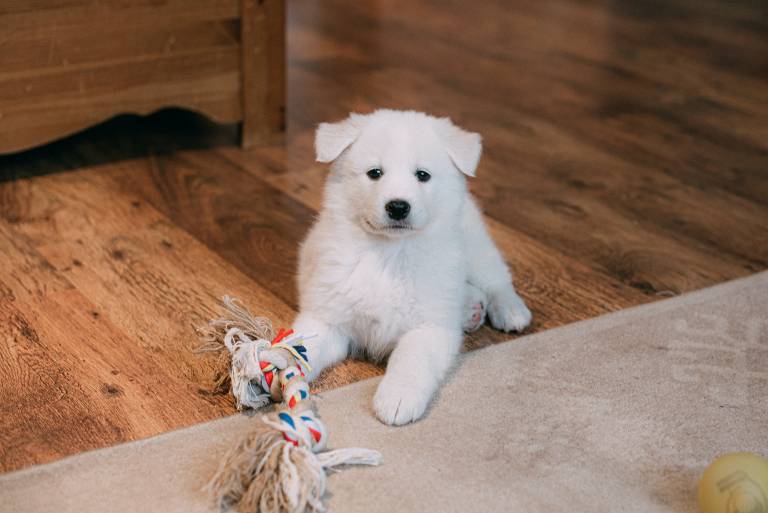Why Do Dogs Like Bones?
Post Date:
December 10, 2024
(Date Last Modified: November 13, 2025)
Domestic dogs interact with animal bones for a mix of biological, sensory, and behavioral reasons.
Evolutionary origins of bone-chewing
Early canids and their descendants evolved as facultative carnivores and scavengers whose feeding ecology included both flesh and hard connective tissues.
In scavenging or heavy feeding episodes, bone and cartilage can make up a substantial portion of consumed mass, sometimes reaching up to 20% of ingested biomass in individual wild canid feeding events[1]. This contribution supplied durable, mineral-rich material when soft tissues were scarce.
Wolves and other wild canids benefit from accessing marrow and breaking bones for nutrient reserves during lean periods; domestication reduced the necessity of scavenging but did not eliminate the behavioral and anatomical adaptations—such as powerful bite force and dental morphology—that favor bone handling.
Nutritional value of bones
Bones are a concentrated source of minerals and structural proteins that matter for canine physiology.
Bone ash is dominated by calcium and phosphorus, and the calcium-to-phosphorus ratio in most mammalian cortical bone is approximately 2:1, which helps explain why bone has been an important dietary calcium source for carnivores and omnivores alike[2].
Beyond minerals, bones contain collagen and other connective-tissue proteins; marrow provides lipids, fat-soluble compounds, and fat-soluble vitamins. The balance of available energy and micronutrients varies by bone type (weight-bearing long bones versus flat bones) and by whether marrow is intact, exposed, cooked, or removed prior to feeding.
Marrow, fat and flavor appeal
Marrow is a dense store of energy and flavor that strongly motivates consumption.
Bone marrow can be very high in fat, commonly in the range of about 50–70% fat by weight in large mammal long-bone marrow, which contributes both caloric density and palatability for dogs[3].
The aromatic and fatty compounds released when marrow is exposed or warmed produce volatile cues that dogs detect readily, and the high energy yield of marrow makes it a high-value reward in wild foraging. For companion animals, marrow’s fat content explains why small amounts can represent a meaningful caloric addition compared with equivalent weights of lean meat.
Chewing instinct and dental benefits
Chewing behaves as a motivated, species-typical activity that exercises the jaw, relieves oral discomfort, and can provide psychological enrichment.
Veterinary dental guidance typically recommends formal home-care measures such as toothbrushing or the use of approved dental chews at a frequency of about 1 per day to maintain oral hygiene; regular mechanical abrasion from appropriate chews can reduce plaque and calculus accumulation when combined with professional care[4].
While hard chewing can abrade plaque and stimulate gums, there are limits: very hard items can cause tooth fractures and some bone types are prone to splintering, so the dental benefit must be balanced against mechanical risk and monitored by pet owners and veterinarians.
Sensory factors: smell, texture and taste
Olfactory cues are central to a dog’s interest in bones; fats, amino-acid breakdown products, and volatile organics produced by marrow and aged tissue are strong attractants.
Texture is also important: bones offer a mix of hard cortex, yielding marrow, and variable crunchiness that provides tactile feedback during chewing. That combination satisfies oral manipulation instincts and can produce prolonged engagement compared with uniform-texture items.
Taste receptors tuned to amino acids and fatty acids, coupled with associative learning from rewarding feeding experiences, reinforce preferences for fatty, savory bones over bland or synthetic items.
Developmental and learned behavior
Puppies show mouthing behaviors that transition into more focused chewing as dentition develops; early exposure to safe chew items and positive reinforcement can shape later preferences without encouraging resource guarding.
Maternal feeding strategies in wild canids sometimes include transfer of softened tissues and marrow to pups, which creates early exposure to bone-associated flavors; in domestic settings, controlled, supervised introduction to appropriate chews can produce similar learned preferences without unnecessary risk.
Breed and individual differences are common: some breeds display stronger object-directed chewing drives and some individuals show little interest in bones at all, reflecting both genetic predisposition and experience.
Social and environmental influences
Context strongly affects how bones are used and valued. In group settings, competition can produce guarding or aggression around high-value items like marrow-rich bones, particularly when resources are scarce or when social hierarchies are unsettled.
Owner practices—such as offering bones routinely, cooking bones, or supervising bone use—shape outcomes; supervised, size-appropriate provisioning reduces many avoidable hazards. Environmental enrichment that provides alternative chew outlets and scheduled feeding decreases the chance of destructive chewing driven by boredom or stress.
Risks, hazards and veterinary concerns
Bones present several medical risks, including choking, dental damage, gastrointestinal obstruction, and perforation from sharp fragments; pathogen contamination is also a consideration for raw items.
Clinical fluid maintenance guidance for dogs uses a standard maintenance estimate of about 50 mL/kg/day for healthy adult animals receiving normal food and water_—_a useful reference for evaluating dehydration risk in dogs that may develop vomiting or diarrhea after bone ingestion[1].
Signs that require veterinary attention include persistent vomiting, abdominal pain or distension, inability to pass stool, fever, or broken teeth; rapid veterinary assessment is important because obstructions and perforations can be life-threatening.
Safe alternatives and feeding guidelines
When people want to offer textured or marrow-like experiences without the full set of risks from whole bones, several safer options exist.
- Commercial dental chews and engineered marrow analogs that are sized to the dog and labeled for safety.
- Durable rubber or nylon chew toys designed for that dog’s bite strength and chewing style.
- Raw, large weight-bearing bones given under supervision, or marrow removed and offered in controlled portions.
As a practical guideline, many veterinary and animal-welfare authorities advise limiting recreational bone offerings to about 1–2 times per week rather than daily, to reduce additive caloric intake and to lower cumulative risk of dental or gastrointestinal problems[5]. Owners should choose bones large enough that they cannot be swallowed whole and should avoid cooked bones that are brittle and prone to splintering.
| Bone type | Typical marrow fat | Typical Ca:P (ash) | Primary hazard |
|---|---|---|---|
| Large beef long bone (raw) | ~60% fat by weight[3] | ≈2:1[2] | Risk: large fragments, obesity if overfed |
| Lamb marrow bone (raw) | ~50% fat by weight[3] | ≈2:1[2] | Risk: splintering if cooked, owner supervision needed |
| Poultry bones (raw or cooked) | Low marrow content | Variable | High splinter and obstruction risk, avoid cooked |
| Synthetic recreational chew | None | Not applicable | Lower ingestion risk; monitor wear and tear |
Many practical choices can reduce risk while preserving the sensory and enrichment benefits dogs get from bones.
Safe handling and preparation
Raw bones carry a risk of bacterial contamination; standard food-safety recommendations for raw meat handling apply, including washing hands and surfaces and storing bones at refrigeration temperatures below 40°F (4°C) until use[1].
Cooked bones become brittle and are significantly more likely to splinter; veterinary guidance advises against offering any cooked femur, rib, or poultry bones because splinters can perforate the esophagus, stomach, or intestines[2].
Size, shape and portion guidelines
Choose bones that are at least as long as the dog’s muzzle so they cannot be swallowed whole; for example, a bone longer than 4 in (10 cm) is often advised for small breeds but owners should match the bone to the individual dog’s head size and chewing force[2].
Because marrow is calorie-dense, limit marrow portions: for a dog of 22 lb (10 kg), offering more than about 1 oz (28 g) of marrow in a single session can add roughly 150 kcal depending on fat concentration and may exceed recommended treat allocation for weight management[3].
Puppies with deciduous teeth or dogs with existing dental fractures should avoid very hard recreational bones; many veterinary dentists recommend delaying access to hard weight-bearing bones until adult dentition is established at around 6–7 months of age for most breeds[4].
Feeding frequency and monitoring
To balance enrichment with safety and calories, a common recommendation is to offer marrow-rich or large recreational bones no more than 1–2 times per week for adult dogs, and to supervise sessions to remove small or broken pieces immediately[5].
If gastrointestinal upset occurs after bone ingestion, monitor hydration closely and follow maintenance fluid estimates of about 50 mL/kg/day while seeking veterinary advice if vomiting or diarrhea persists beyond 24 hours[1].
Special considerations by age, health and size
Small dogs under about 10 lb (4.5 kg) are at proportionally greater choking and obstruction risk from marrow-rich bones and small fragments; many veterinarians advise alternative chews for these dogs[2].
Dogs with pancreatitis or a history of hyperlipidemia should avoid marrow and very fatty treats because marrow pieces can be >50% fat by weight and may precipitate recurrent pancreatitis in predisposed animals[3].
For geriatric dogs or those with compromised dentition, softer dental chews or veterinary-recommended oral care products are safer; some professional guidelines suggest daily toothbrushing plus periodic veterinary cleanings rather than hard bones for these patients[4].
When to involve a veterinarian
Seek veterinary care immediately if a dog shows continuous retching, repeated unproductive attempts to vomit, abdominal swelling, obvious oral bleeding, or a sudden change in behavior after chewing a bone, because obstructions and perforations require prompt diagnosis and intervention[1].
Dental fractures may be subtle; if a dog stops chewing on one side, drools more than usual, or shows aversion to hard food, a dental exam is warranted because tooth-root exposure and pain can occur even without obvious external fracture fragments[4].
Practical summary for owners
Owners who value the enrichment and flavor bones provide can reduce harm by selecting large, raw weight-bearing bones for adult dogs only, supervising every session, limiting marrow portions to small amounts relative to daily caloric needs, avoiding cooked bones entirely, and substituting commercial veterinary dental products when appropriate; adhere to basic food-safety handling and consult a veterinarian for individualized risk assessment[2].
When used carefully, bones and bone-like items can satisfy natural drives and provide nutrition and enrichment, but prudent selection, portion control, and supervision are essential to minimize the measurable risks associated with their use.






